When he first learned about his job in the Sierras, Braden never expected that it would provide him with a great opportunity to observe hard-to-find sagebrush species—including some of our top Nemesis Birds! It also helped move him closer to his revised Big Year goal of 500 species and the coveted 1,000 species mark on his Life List!
A concept my dad and I have perfected over the years is that of putting in a certain number of hours to locate every bird species. Unfortunately (or perhaps, fortunately), not every bird will just be sitting there in the parking lot when you arrive in a place to look for it, and it is not uncommon to completely miss a highly sought-after species. After a certain number of misses, in fact, that species becomes a nemesis bird. Every birder has or has had a nemesis bird, and that led me to think about the fact that for every single person, the number of hours “required” to see each species is unique. To get a Blue Jay, for example, a birder in the Western United States may have to search for more than ten hours, performing multiple searches at multiple locations to add this bird to his life list, while a beginning birder in Massachusetts may only have to put in five minutes or thirty seconds. Even in less extreme geographical situations, the number of hours people put in for a bird varies. My dad and I invested double-digit hours into finding an American Bittern, whereas other Montana birders just seemed to stumble onto them.
On June 25th, as my co-worker Sam Darmstadt and I crossed Sonora Pass, heading for the dry lands of the eastern side of the Sierras, we had many target birds in mind that I had already logged many hours trying to see. The first was one my dad and I had looked for at least four times, designating it as a nemesis bird, and apparently, I had finally put in enough hours for it, because as soon as we hopped out of the car on a dirt road near Mono Lake, there it was: a Sagebrush Sparrow, posing in perfect view for us on top of its namesake plant.
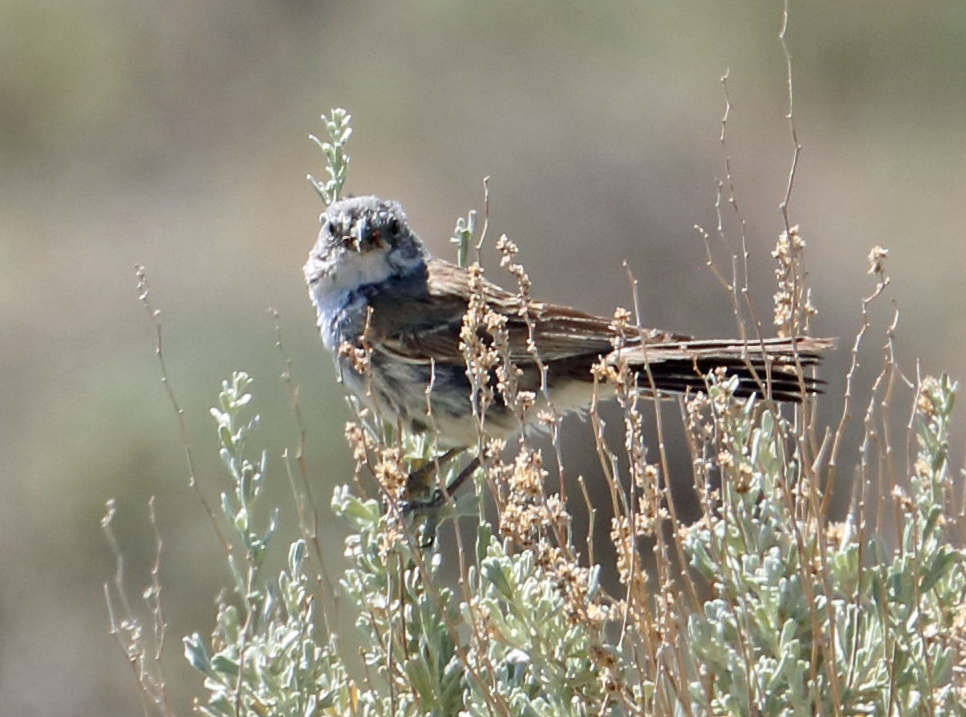
“Was it too easy?” asked Sam, as I snapped photos of this lifer. The open sagebrush plains we stood in appeared to be perfect habitat for the species, and we spotted several more as we continued down the road. In fact, it was one of the only birds in this habitat, along with Sage Thrasher and Brewer’s Sparrow, which also gave us great looks. I glanced at the strange tufa columns (calcium precipitations) rising up from Mono Lake in the distance before getting back in the car on the way to our next target for the day. This was another sage bird, one I’d only seen once and Sam had never seen: Greater Sage-Grouse.
Again, my dad and I (sometimes with Nick in tow) had looked for this species multiple times across the various Eastern Montana locales it frequented, but with very limited success. It had been five years since we’d seen our lifers, a mother with two chicks on Bentonite Road, the same road where everyone in Montana goes to get their Mountain Plovers for the year. Where Sam and I were now, at Lake Crowley, was about as different a place from Bentonite Road as possible while still supporting expansive sagebrush habitat. Ponderosa (or Jeffrey’s) Pines rose in the distance, a symbol of our high elevation despite having left the Sierras. And speaking of the Sierras, there they towered in front of us, their craggy slopes rising towards sharpened peaks sprinkled with lingering snow patches.
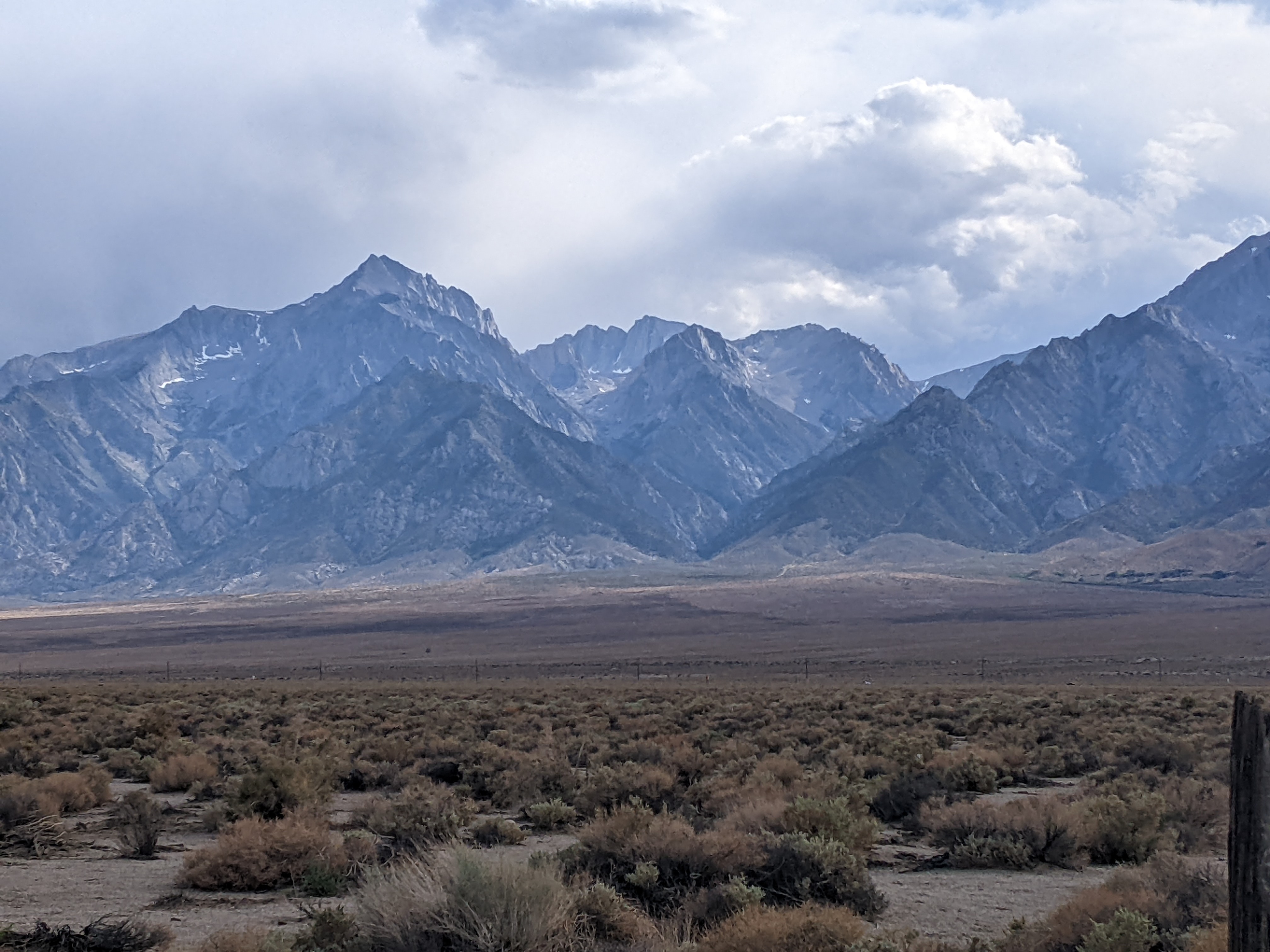
We slowly drove the dusty road through the sagebrush towards the lake, flushing Horned Larks, Brewer’s Sparrows and yet more Sagebrush Sparrows off the road in front of us. Despite squinting as we scanned for grouse heads, we did not find any. Upon reaching the lake, we added a few water birds to our list, including American Avocet, Long-billed Curlew, Eared Grebe and Ruddy Duck. Then we slowly began making our way back.
The Sierras are an incredibly diverse ecosystem and help make California a biodiversity hotspot, and we experienced that for ourselves on our drive through the sagebrush. Over the mountains above us, dark gray clouds loomed, dumping rain on the rocky peaks. Sam and I both flinched as lightning bolts struck the highest points, the thunder echoing across the valley. However, while many of the clouds drifted over our heads, the rain barely reached us. The Western Sierra had a day full of rain, while over here, we got a few drops at most. This rain shadow, created by the tallest mountains in the Lower 48, allowed sagebrush to flourish here while oak savannah covered the western foothills only twenty miles away. And the mountains didn’t just block storms. They blocked birds, too. Many of California’s famous specialty birds, including Wrentit, California Thrasher and Yellow-billed Magpie, simply could not make it over these mountains. Without the Sierras blocking their paths, these endemic or near-endemic birds probably wouldn’t have evolved into their own species in the first place.
Meanwhile, here on the east side of the mountains, a familiar Black-billed Magpie flew over the car as we turned down one last road in an effort to find grouse. After about a mile, I turned to look over my shoulder just as three giant ground birds erupted from right next to the car, landing a short distance away.
“Grouse!” I shouted, “Get out! Get out!”
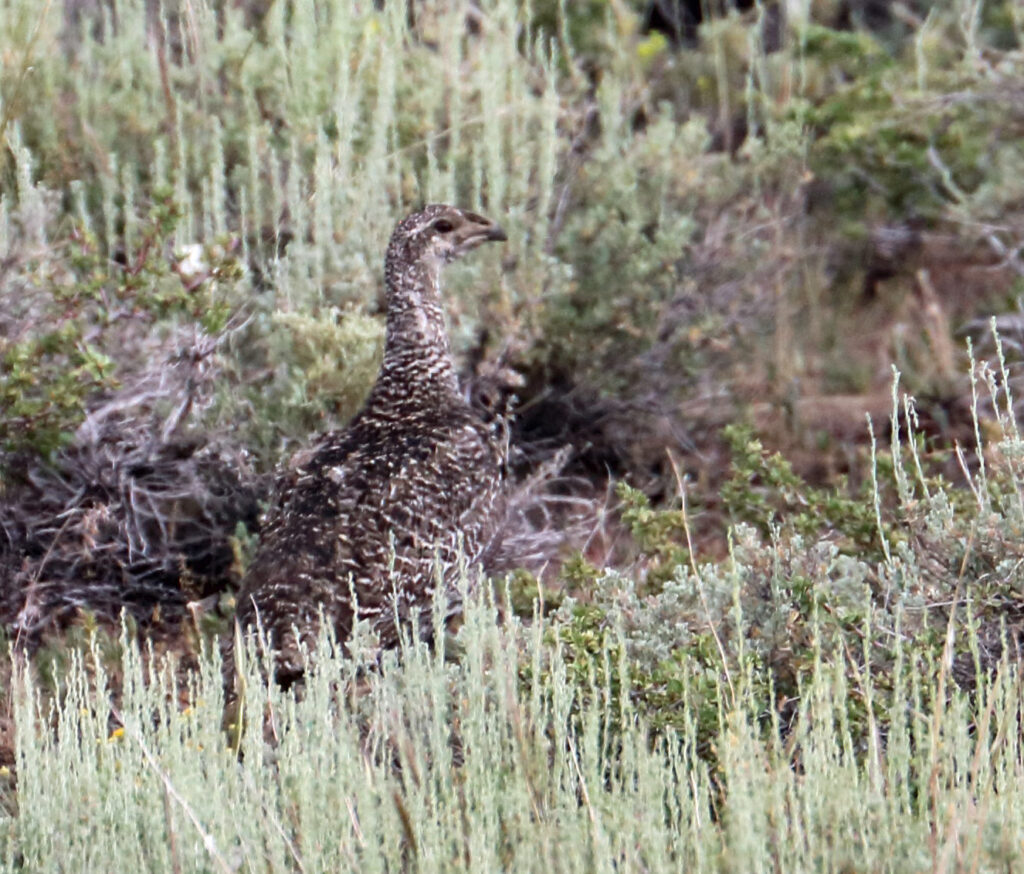
We soon spotted one of them: a female Greater Sage-Grouse wandering through brush rising up to its shoulders. We high-fived, relishing the moment as we watched the rare bird move away from us.
Farther south, we stopped briefly at a canyon for an unsuccessful try at Black Swift, and filled up at the least expensive gas station we could find in Bishop, California. Continuing down Hwy 395, the mountains grew yet higher, and we soon found ourselves almost under the shadow of Mt. Whitney, the tallest mountain in the Lower 48. We couldn’t see Whitney, but could see many of the other 14,000-footers looming above us, their sides even more devoid of vegetation than the mountains we’d seen farther north. The sage quickly evaporated around us, giving way to desert brush as we left the Great Basin and entered the Mojave. Why had we come so far?
One reason: LeConte’s Thrasher.
This enigmatic thrasher makes its home in some of the most desolate habitats in North America, inspiring Sam’s non-honorific name for it, the Desolation Thrasher. It’s a species my dad and I had already put in several hours searching for, as we explored a barren salt desert on our way from Southeast Arizona to San Diego. This gorgeous, understated bird matches its habitat, its sandy feathers accented by a slightly peach-colored vent. It’s dark eye, a feature it does not share with the rest of the desert thrashers, matches the black color of its extremely curved bill. Almost nothing else lives in the sparse habitats this bird occupies, and needless to say, I had been obsessed with the species since missing it in Arizona a month before.
Our previous plan had been to camp in some nearby hills that night, then look for the thrasher in the morning. However, with time to spare, we decided to head towards a spot that had produced a few reports in previous years.
“Let’s start putting in the hours,” I said as we made the decision, trying to maximize our chances of seeing my number one target for the trip.
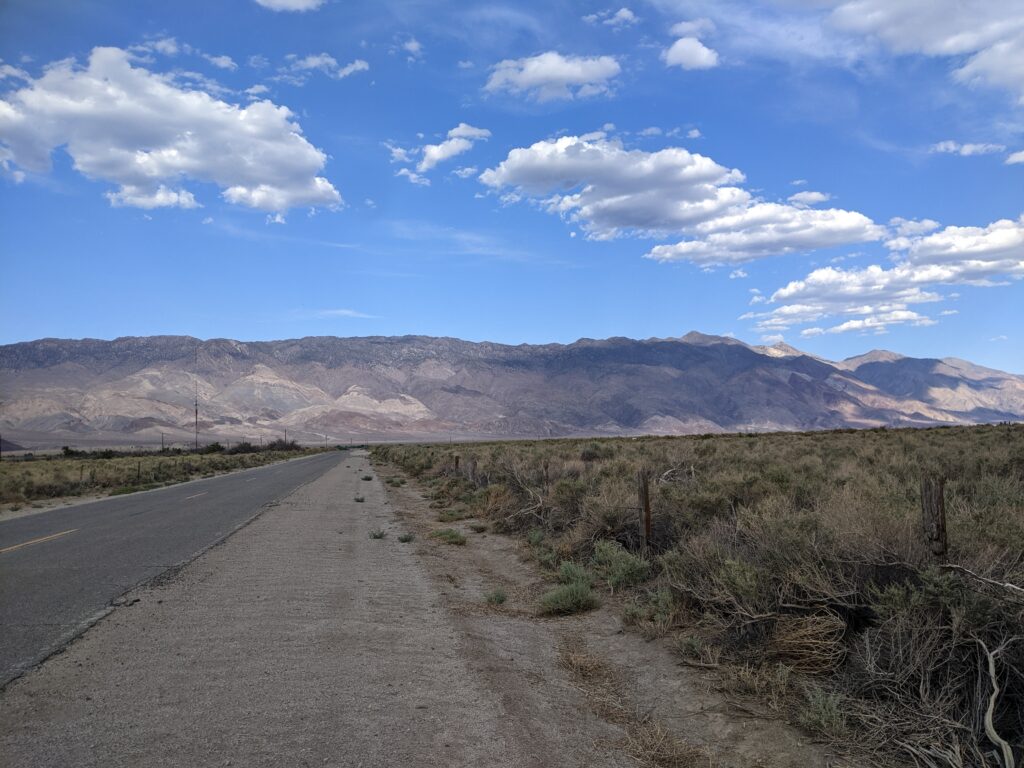
While the road wasn’t as desolate as the salt desert my dad and I had searched in Arizona, it certainly was barren. Dry, orange brush rose from the sandy ground, and as we piled out of the car to begin playing for the thrasher, it became clear that birds here were few and far between.
At every stop we made, I played the songs of both LeConte’s Thrasher and Black-chinned Sparrow, the latter another bird we hoped to find. I also pished vigorously at the brush, hoping that these enigmatic birds would respond. After one round of doing this, the situation looked bleak. The only birds we saw were distant ravens on a telephone pole, and temperatures pushed ninety degrees at 5 pm, a radical change from the seventies weather we’d been experiencing only an hour north in sagebrush country. It would have been hotter if not for the storm clouds dumping rain that would never reach us. Another point against us was that the thrashers, and all the desert birds, were significantly less active now that it was almost July. In the desert, spring starts early, and most of the reports on this road had been from March and April.
At the second spot, we added Turkey Vulture to the list, though still couldn’t find any birds actively using the desert habitat. I switched up my playback strategy at the third spot, pishing first then playing the thrasher and sparrow songs. Just as the Black-chinned Sparrow recording stopped, I spotted a bird hop up on a fence to our right. Turning my head, I saw the sandy feathers and curved bill—and freaked out.
“Sam!” I whisper-shouted, “It’s there! It’s there! Do you see it??”
“Oh my god!” was the reply.
I slowly reached for my camera, never taking my eyes off the thrasher. The bird’s tail raised and lowered, and the bird looked around, trying to spot the enemy thrasher that had invaded its territory. After I snapped some surprisingly good photographs, it flew over to another bush. The smiles on our faces could not have been erased by anything, and they remained plastered to our faces for another half an hour. We’d just seen one of North America’s rarest breeding birds—after completely expecting to miss it!
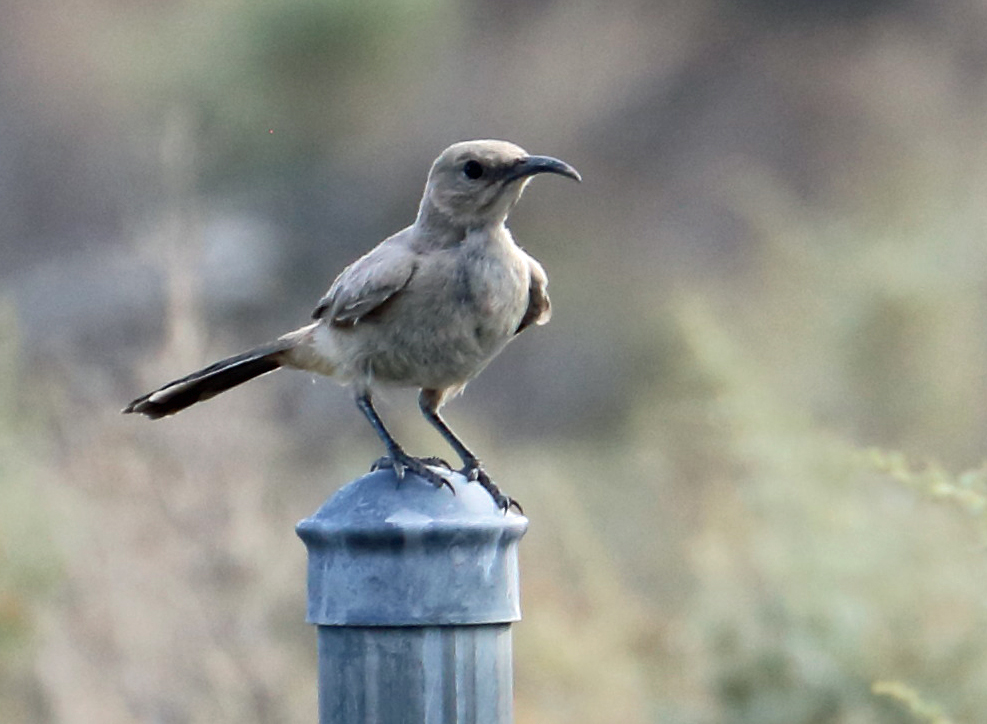
The thrasher, the grouse and the sparrow had all been birds I’d looked for before, and June 25th, 2022 had been the day to cash in my hours searching for all three species. Even as I write this now, I am still in shock at the looks this desert shadow provided us with, after only looking for it twice! I’d expected to return home without the thrasher and even more determination to see one, and instead, I’d been given an experience I’d never forget. Within a few minutes, LeConte’s Thrasher was already a contender for my Bird of the Year.
The rest of the trip, driving north the next day, went well and included birding an Ancient Bristlecone Pine Forest! Ironically, we found none of our other target species. They were all birds I’d never looked for before: Virginia’s Warbler, Black-chinned Sparrow and Gray Vireo. I guess that means I haven’t yet put in the hours!
Braden’s Statistics Through This Report
ABA Species for 2022 (goal 500): 438 species
Life List Count: 996 species

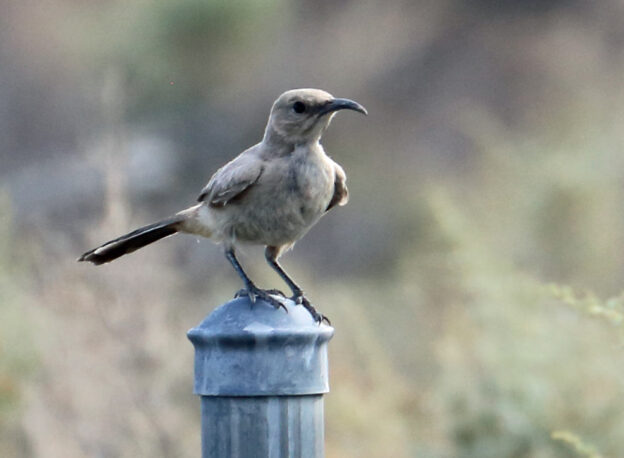
Oh man what an exciting post! Loved the suspense. I have a thrasher in my backyard and the blue jay is afraid of him.
Interesting. I just love love these blogs! So proud of your tenacity and story telling skills. Til next time, love you! Ma
another fun adventure! I LOVE the photo of the LeConte’s Thrasher and the sparrow!!! Looks like they were posing for you. just wonderful. great job.
Congrats on those rare Lifers! Persistence pays off, at least sometimes. Great Thrasher photo.
Loved the back story of how certain species devolve into nemesis birds over time.
Closing in on 1,000 species, just WOW!
Oh my gosh,Sneed(ie).. Braden has all your story telling skills ! This is a magical journal he’s logged. Excellent guidance,dad♥️
Hi Mom! Welcome to the comments! Yes, Braden not only has great story-telling skills, these days he has a lot more stories to tell! So glad you are enjoying them!
Love the east side! Birds are great and the vistas are stunning.